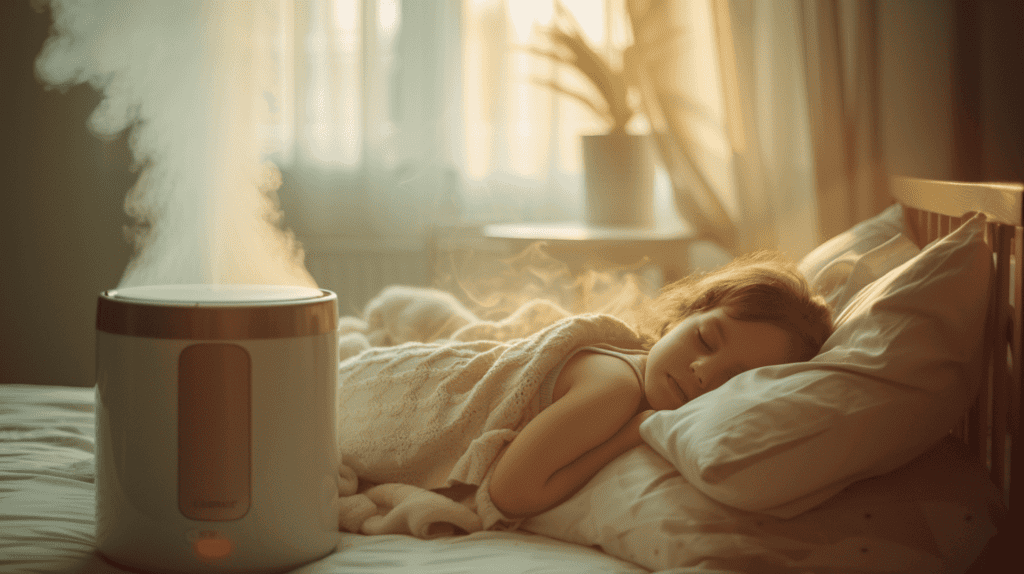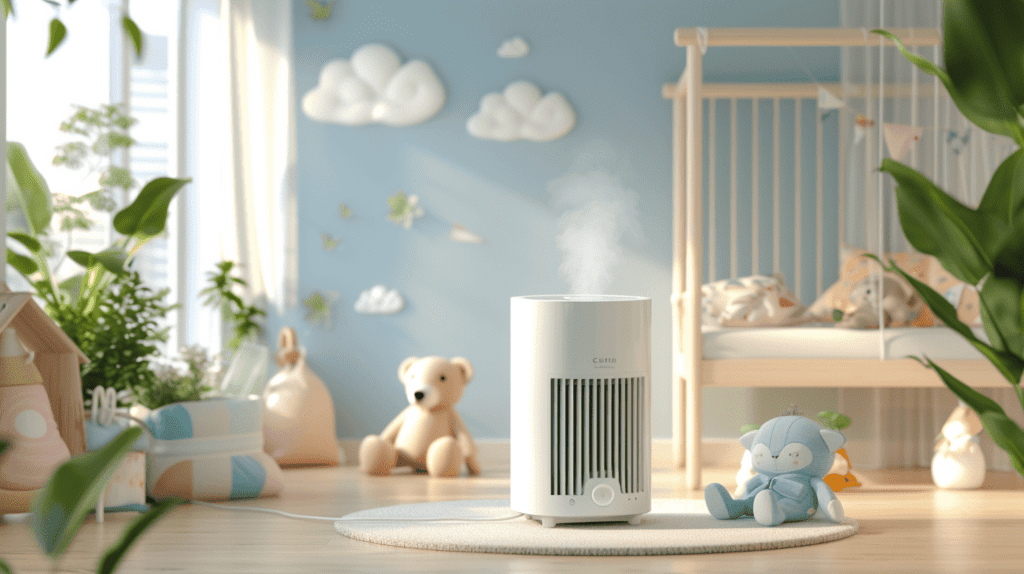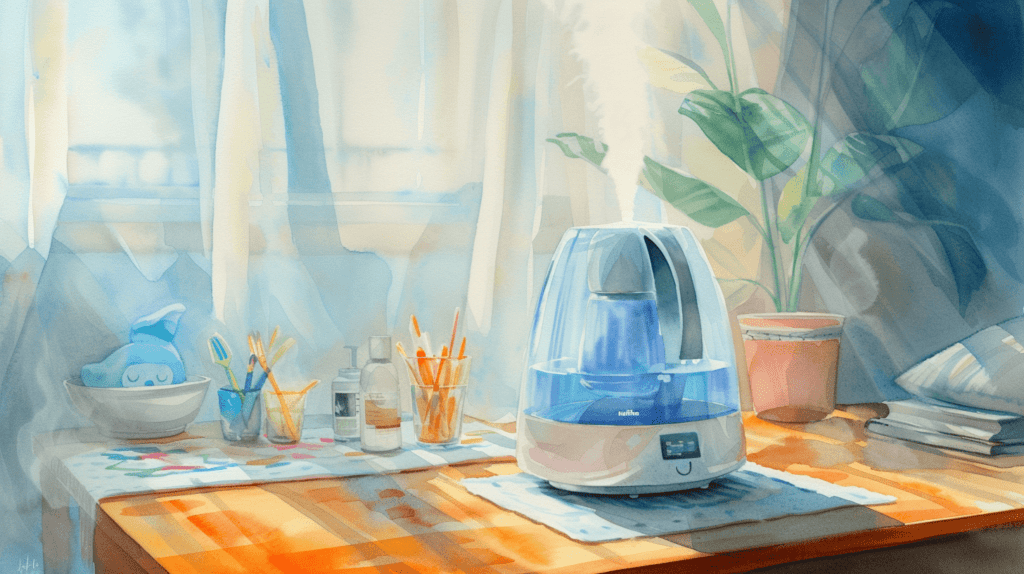
In the cooler months, when the air from the heating tickles our noses and makes our skin tense, the usefulness of humidifiers in the children's room is often discussed.
But what is really the situation with these devices that promise to make the indoor air more pleasant for our little ones? Can they really help improve the health and well-being of our children, or do they pose unexpected risks? In this article, we delve deep into the world of humidifiers to find out whether they are friend or foe in your child's room. We look at the advantages and disadvantages, give tips on the right selection and use and help you make a well-considered decision.
Get ready for an informative journey through the humid terrain of humidifiers - without any clouds of fog.
Humidifiers play a crucial role in children's rooms, especially during the heating season, to maintain humidity at an optimal level and therefore support children's health and well-being. But the decision for or against a humidifier should be carefully considered, as both positive effects and potential risks must be taken into account.
Summary of key factors:
| factors | Benefits | Disadvantages and risks |
|---|---|---|
| Health Effects | Relief from dry skin and respiratory problems; Support for allergies | risk of germ spread; Promotes mold, bacteria and mites when the humidity is too high |
| Type choice | Ultrasonic humidifiers and air washers preferred because of safety and quiet operation | Evaporators are less suitable due to the risk of burns and possible noise pollution |
| safety and hygiene | Daily filling with fresh water and regular cleaning to prevent germ formation | Neglecting cleaning can promote health risks |
| Humidity control | Using a hygrometer to monitor and maintain ideal levels | Overhumidification can create unhealthy living conditions |
| sleep quality | Quiet operation promotes undisturbed sleep | Noise can affect sleep quality |
In the following sections, we will discuss each of these elements in detail to provide parents with an informed decision-making aid.
Table of Contents
ToggleHumidifier in the children's room: good or bad?
 Positive effects of humidifiers
Positive effects of humidifiers
Humidifiers can work wonders in a child's room, especially when it comes to... dry skin, allergies and sleep problems goes. Increasing humidity helps relieve dry skin symptoms by providing adequate hydration. Children with sensitive skin particularly benefit from improved air quality, as dry air often increases itching and irritation.
Humidifiers play a dual role when it comes to allergies. Not only do they help regulate humidity, but they can also reduce the amount of allergens floating in the air. This happens by binding dust and pollen in the water droplets, which then sink to the ground and thus clean the air.
Sleep problems in children can also be positively influenced by using a humidifier. Adequate humidity makes breathing easier during the night and can therefore lead to deeper and undisturbed sleep. Especially during the heating season, when the air is particularly dry, a humidifier can ensure a more pleasant sleeping environment.
| Advantage | Declaration |
|---|---|
| Relieving dry skin | Increases humidity, which helps hydrate the skin and can reduce irritation. |
| Support for allergies | Binds allergens into water droplets that sink to the ground, reducing allergen exposure. |
| Improve sleep | Makes breathing easier and promotes deeper, undisturbed sleep. |
Practical example: In a children's room with a humidifier, parents notice that their child, who previously often had dry skin and... stuffy nose at night woke up, now slept through. The child's skin shows visible improvements and the nose is less stuffy, due to the improved humidity.
Possible risks from humidifiers
Während Humidifiers offer many advantages, the possible risks must not be ignored. This can happen if the humidity is too high Growth of mold, bacteria and mites promote, which in turn can trigger health problems such as respiratory diseases and allergies. Excessive humidity can become an ideal breeding ground for mold, especially in poorly ventilated rooms.
Cleaning your humidifier regularly is crucial to prevent the spread of bacteria and mold. Stagnant water in the tank can become a breeding ground for microorganisms, which are then distributed through the air in the child's room.
| Risks | Prävention |
|---|---|
| Growth of molds | Regular ventilation and monitoring of humidity to keep it in the optimal range (40-60%). |
| Spread of bacteria | Clean and disinfect the humidifier daily to prevent germ formation. |
| Promote mite growth | Use of hygrometers to precisely control humidity and avoid over-humidification. |
It is important to find a balance and the Humidity in the children's room to keep an eye on both to reap the benefits and minimize the risks. A hygrometer can help monitor humidity and ensure it remains within the optimal range.
Choosing the right humidifier
Difference Between Humidifiers and Air Washers: Which is Better for Allergic Children?
Choosing between a humidifier and an air washer can be particularly important for parents of allergic children. Humidifiers are primarily used to increase the humidity in a room, which can help relieve dry air symptoms such as irritated respiratory tract and dry skin. Air washers, on the other hand, fulfill a dual function: They not only humidify the air, but also clean it of allergens such as dust, pollen and animal hair. This can make a significant difference for children with allergies or asthma.
- humidifier simply increase the humidity without cleaning the air of particles.
- Air washer combine air humidification with a cleaning component that effectively filters allergens from the air.
For families with allergic children, air washers are often a better choice because they help improve air quality by removing allergens while maintaining comfortable humidity levels.
Practical example: A child with house dust allergy shows a significant improvement in symptoms after an air washer was installed in the child's room. Parents notice less sneezing and an improved quality of sleep for the child, as the air is not only pleasantly humidified but also cleaned of dust and mites.
Important functions and features of an ideal humidifier for the children's room
When choosing a humidifier for the child's room, parents should pay attention to certain functions and features to ensure that the device is not only effective but also safe.
- Safety: Devices without hot water or steam are preferred to avoid the risk of burns.
- Noise level: Quiet operation is important so that the child's sleep is not disturbed.
- Cleaning and maintenance: Easy cleaning and maintenance are crucial to prevent bacteria and mold from forming.
- Hygrostat: An integrated hygrostat allows the humidity to be automatically regulated at an optimal level.
- Filter: Models with filters can also provide air purification and are particularly recommended for allergic children.
| characteristics | Importance for the children's room |
|---|---|
| Safety | Minimizes risks such as burns or contact with hot steam. |
| noise | Provides a quiet sleeping environment. |
| cleaning and maintenance | Prevents the accumulation of pollutants and germs. |
| Hygrostat | Automatically keeps humidity at a healthy level. |
| Filter | Provides additional protection against allergens and improves air quality. |
Choosing the right humidifier or air scrubber can be crucial to creating a healthy and comfortable environment in your child's room. Especially for allergic children, choosing a device that both humidifies and purifies the air can bring significant benefits to their well-being and health.
Safety and hygiene aspects
 Proper use and care of humidifiers to avoid health risks
Proper use and care of humidifiers to avoid health risks
Proper use and care of humidifiers is critical to minimizing health risks such as the spread of bacteria and mold. A central aspect is regular cleaning and maintenance of the device. Humidifiers that are not cleaned properly can become a breeding ground for microorganisms that are then released into the indoor air. This can lead to respiratory problems, allergies and other health problems.
Important steps for safe use:
- Always use distilled or demineralized water to avoid limescale buildup and the release of minerals into the air.
- Make sure the humidifier is on a solid, flat surface to prevent it from tipping over.
- Keep the device out of the reach of children to keep prying hands away.
Recommendations for daily filling with fresh water and weekly cleaning
To ensure a healthy indoor climate, it is important to fill the humidifier with fresh water every day and clean it thoroughly at least once a week. This prevents the formation and spread of germs.
Daily routines:
- Empty the water reservoir daily and refill it with fresh water before using the humidifier again.
Weekly cleaning recommendations:
- Disassemble the device according to the manufacturer's instructions.
- Thoroughly clean all parts that come into contact with water with a mild soap solution.
- Thoroughly rinse all cleaned parts to remove any soap residue.
- Disinfection with a vinegar solution should be carried out once a week to dissolve limescale deposits and inhibit the growth of bacteria and mold.
- Allow all parts to dry completely before reassembling and operating the humidifier.
| Care step | Häufigkeit | Purpose |
|---|---|---|
| Water change | Daily | Prevents germ formation and guarantees the use of fresh water. |
| Cleaning | Weekly | Removes dirt and debris that accumulates in the device. |
| Disinfection | Weekly | Inhibits the growth of bacteria and mold. |
Practical example: A family notices a musty smell after using a humidifier in the children's room for a few weeks. After following the recommendations for daily filling with fresh water and weekly cleaning and disinfection, the air quality in the room improves significantly and the unpleasant smell disappears.
By following these simple care instructions, you can ensure that your humidifier works effectively and creates a healthy indoor environment for your family.
Optimal humidity in the children's room
How to monitor the humidity in the room and keep it at an ideal level between 40 and 60 percent
Maintaining optimal humidity in your child's room is crucial for your child's health and well-being. A level between 40 and 60 percent is considered ideal for creating a healthy indoor climate in which children feel comfortable and health problems such as dry skin or respiratory problems are minimized.
To effectively monitor the humidity in the child's room, it is recommended to use a hygrometer. This measures the current humidity and allows you to make adjustments if the values are outside the ideal range. Modern humidifiers are often already equipped with an integrated hygrometer that automatically regulates the humidity and switches the device on or off to achieve the desired values.
Steps to regulate humidity:
- Monitoring: Install a hygrometer to continually monitor humidity.
- Adjustment: Use a humidifier to increase humidity if necessary.
- Airing: Open windows regularly to let in fresh air and avoid over-humidification.
Tips to avoid problems caused by excessive humidity
Humidity that is too high can be just as problematic as humidity that is too low. It can promote the growth of mold, bacteria and mites, which can cause health problems for your child. To avoid this, it is important to take measures to prevent excessive moisture in the child's room.
Preventive action:
- Regular ventilation: By opening the windows several times a day, you allow excess moisture to escape and fresh air to flow in.
- Dehumidifier: In particularly humid rooms, using a dehumidifier can make sense to reduce the humidity.
- Plants: Certain houseplants can help regulate humidity. However, be careful not to place too many plants in the nursery as they can also contribute to humidity.
| measure | Purpose |
|---|---|
| Regular airing | Prevents build-up of moist air and mold formation. |
| dehumidifiers | Actively reduces humidity in particularly humid rooms. |
| plants | Natural regulation of air humidity without technical devices. |
Practical example: After setting up a hygrometer in the child's room, parents notice that the humidity often rises to over 60 percent, especially after bathing the child. By introducing regular ventilation times and purchasing a dehumidifier, you can effectively reduce the humidity and keep it at a healthy level.
By following these tips, you can ensure that the humidity in the child's room is optimally regulated and that your child grows up in a healthy environment.
Sleep quality and noise pollution
The importance of a quiet humidifier for the child's undisturbed sleep
Undisturbed, restful sleep is essential for the development and well-being of children. Noise levels in children's rooms, especially from household appliances such as humidifiers, can seriously disrupt sleep. That's why choosing a quiet humidifier is so important. Models that are specifically designed for use in children's rooms minimize noise pollution and thus promote a quiet sleeping environment. The noise level should ideally be below 30 dB so as not to affect the quality of sleep.
Recommendations for quiet models and placement tips in the room
When choosing a quiet humidifier, you should pay attention to the manufacturer's noise specifications and prefer models that are labeled as particularly quiet. Ultrasonic humidifiers are generally considered to be very quiet, making them a good choice for children's rooms.
Recommended quiet humidifier models:
- Ultrasonic Humidifiers: Known for their whisper-quiet operation.
- Low noise evaporator: An alternative to ultrasonic devices, also quiet in operation.
Placement tips in the room:
- Distance to bed: The humidifier should not be placed directly next to the bed or cradle to avoid direct noise.
- On a stable surface: Place the device on a firm, stable surface to minimize vibration and associated noise.
- Central in the room: Central placement in the room allows for even distribution of humidified air without having to place the device too close to the sleeping area.
| placement | Purpose |
|---|---|
| Distance from the bed | Avoid direct noise impact on the sleeping child. |
| On a stable surface | Reduction of vibrations and associated noise. |
| Central in the room | Even distribution of air humidity with minimized noise pollution. |
Practical example: Parents bought a new humidifier and noticed that their child has been sleeping more peacefully since then. You deliberately do not place the device directly next to the bed, but rather on a cupboard in the middle of the room. This results in an even distribution of moisture without the child being disturbed by operating noises.
The right choice and placement of a humidifier can go a long way toward improving your child's sleep quality and creating a peaceful sleep environment.
Infographic: Sales of humidifiers are increasing in Switzerland
 In 2022, around 48.000 humidifiers and air purifiers were sold in Switzerland, a sign of the population's growing awareness of indoor air quality. These devices not only help improve humidity, but also help prevent health problems such as dry skin, irritated eyes and respiratory diseases. The market offers a variety of products for different needs and room sizes, from classic humidifiers to modern ultrasonic nebulizers. The statistics highlight the importance of air quality products in homes and offices to create a healthy and comfortable indoor climate.
In 2022, around 48.000 humidifiers and air purifiers were sold in Switzerland, a sign of the population's growing awareness of indoor air quality. These devices not only help improve humidity, but also help prevent health problems such as dry skin, irritated eyes and respiratory diseases. The market offers a variety of products for different needs and room sizes, from classic humidifiers to modern ultrasonic nebulizers. The statistics highlight the importance of air quality products in homes and offices to create a healthy and comfortable indoor climate.
Source: Statistics 2022
Personal experiences from acquaintances/friends
Last winter I visited my friend Sarah in her new apartment. She recently bought a humidifier for her little daughter Emma's bedroom because she often suffered from dry skin and a stuffy nose.
At first Sarah was very happy with the device because Emma's skin improved and she slept more peacefully. However, after a while Sarah noticed a musty smell in the children's room. As she looked for the cause, she noticed that mold had formed in the humidifier because she hadn't cleaned it regularly.
Sarah immediately removed the mold and thoroughly disinfected the device. Since then, she has been very conscientious about the weekly cleaning and makes sure to empty the water tank every day and fill it with fresh water. The musty smell has disappeared and Emma can continue to benefit from the improved humidity.
Conclusion
Summary of key findings and tips for using humidifiers in children's rooms
Using a humidifier in your child's room can provide significant benefits to your child's health and well-being, from relieving dry skin and respiratory problems to improving sleep quality. However, it is important to select the right device and ensure careful maintenance to minimize potential risks. The ideal humidity in the child's room should be between 40 and 60 percent to create a healthy indoor climate and prevent the growth of mold, bacteria and mites.
Important tips for using humidifiers in children's rooms:
- Choose quiet models so as not to disturb your child's sleep.
- Ensure regular cleaning and maintenance to prevent the spread of germs.
- Use a hygrometer to keep humidity within the optimal range.
- Place the humidifier safely and out of the reach of children.
Final thoughts on weighing the pros and cons for healthy indoor air
The decision to use a humidifier in a child's room should involve careful consideration of the pros and cons. While the benefits such as improved air quality and relief from health problems are compelling, the potential risks cannot be ignored. Responsible use and regular care of the device are essential to take full advantage of the benefits and minimize possible disadvantages.
Practical example: A couple of parents decide on an ultrasonic humidifier with an integrated hygrometer and pay attention to thorough weekly cleaning. You will notice a significant improvement in your child's air quality and sleep, without any negative effects from excessive humidity or the spread of germs.
Ultimately, a humidifier can be a valuable addition to a child's room as long as it is used wisely and with all safety and hygiene aspects in mind. By following the tips and recommendations summarized here, you can create a healthy and pleasant indoor climate for your child.
Our humidifier recommendations:
FAQ: Frequently asked questions about humidifiers in children's rooms
The frequency of filter replacement depends on the specific model and frequency of use. It is generally recommended to change the filter approximately every 1-3 months, or according to the manufacturer's instructions. More frequent changes may be necessary for intensive use or in areas with hard water.
If used correctly and cleaned regularly, a humidifier should not worsen asthma or allergies and may even provide relief by humidifying dry air. However, improper use, such as excessive humidification or lack of cleaning, can lead to mold growth and an increase in mites, which can worsen asthma and allergies.
The easiest way to monitor humidity in a child's room is to use a hygrometer. These devices measure current humidity and allow you to make adjustments to achieve and maintain the ideal range of 40-60% humidity.
Yes, ultrasonic humidifiers are safe for use in a child's room provided they are used properly and cleaned regularly. These devices work without hot steam, which eliminates the risk of burns. However, it is important to keep an eye on humidity to avoid over-humidification.
White dust occurs when minerals from hard tap water are released into the air by the humidifier. To avoid this, you can use distilled or demineralized water, which does not contain minerals. Some humidifiers also have built-in filters or demineralization cassettes that help reduce the release of minerals.

 Positive effects of humidifiers
Positive effects of humidifiers Proper use and care of humidifiers to avoid health risks
Proper use and care of humidifiers to avoid health risks

